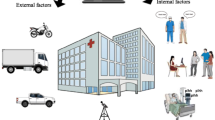Abstract
The hypoxic environment at high altitudes causes various sleep disorders. Diffuse oxygen enrichment is an effective way to alleviate sleep disorders and improve the built environment in high altitude areas. In this study, a novel point source local diffuse oxygen supply method was proposed to improve the sleeping oxygen environment. The oxygen supply performance was investigated by the computational fluid dynamics (CFD) method including the oxygen concentration and air velocity distributions. A sleeping experiment was conducted on the plateau to validate the CFD model. The occupied zone including the inhalation zone and the active zone was defined. The results showed that the oxygen concentration showed a rapid rise, then decreased slowly, and finally tended to be stable. The oxygen concentration after stabilization was remarkably influenced by indoor ventilation rate. The sleeping environment’s improvement was examined considering the oxygen enrichment efficiency, uniformity, stability and human comfort demand. The optimal strategies were recommended with a ventilation rate of 1 air change per hour, supplied oxygen concentration of 90%, and jet distance of 0.50 m. The study contributes to improving the oxygen environment and human sleep quality in an effective and energy-saving approach to the sustainable development of buildings in high altitude areas.
Similar content being viewed by others
Abbreviations
- b :
-
distance from the axis to the jet boundary (m)
- C :
-
concentration (%)
- C 1, C 2 :
-
constants
- C e :
-
concentration of pollutants in the inhaled air without personalized ventilation (%)
- C eo :
-
average oxygen concentration in the inhalation zone without oxygen supply (%)
- C i :
-
concentration of pollutants in the inhaled air (%)
- C io :
-
average oxygen concentration in the inhalation zone (%)
- C o :
-
oxygen supply concentration (%)
- C s :
-
concentration of pollutants in the personalized ventilation air (%)
- C so :
-
oxygen concentration in the oxygen supply gas (%)
- d :
-
outlet diameter (m)
- I :
-
turbulence intensity (%)
- k :
-
turbulent flow energy
- Q :
-
total flow rate of the outlet (m3/s)
- Q o :
-
oxygen supply rate (m3/s)
- r :
-
vertical distance from the axis (m)
- S φ :
-
source term
- T :
-
temperature (K)
- t :
-
time (s)
- U :
-
mean flow velocity (m/s)
- u :
-
velocity distribution (m/s)
- u 0 :
-
outlet velocity (m/s)
- u m :
-
jet axis velocity (m/s)
- v :
-
velocity (m/s)
- x :
-
jet axial distance (m)
- Γ :
-
diffusion coefficient
- ε :
-
dissipation rate
- ε p :
-
index of individual exposure
- η :
-
percentage of oxygen supply gas in inhaled air (%)
- ρ :
-
density (kg/m3)
- φ :
-
general variable
- ACH:
-
air changes per hour
- AZ:
-
active zone
- BZ:
-
breathing zone
- DOS:
-
diffuse oxygen supply
- DR:
-
draft risk
- FSR:
-
facial-area speed ratio
- IZ:
-
inhalation zone
- JD:
-
jet distance
- LAS:
-
local air supply
- LDOS:
-
local diffuse oxygen supply
- MOC:
-
mean oxygen concentration
- NOPS:
-
number of point sources
- OSC:
-
oxygen supply concentration
- OSOD:
-
oxygen supply outlet diameter
- OSR:
-
oxygen supply rate
- POIE:
-
personal oxygen inhalation efficiency
- VR:
-
ventilation rate
References
Ai ZT, Melikov AK (2018). Airborne spread of expiratory droplet nuclei between the occupants of indoor environments: a review. Indoor Air, 28: 500–524.
ANSI/ASHRAE Standard 55-2017 (2017). Thermal Environmental Conditions for Human Occupancy.
ANSYS (2011). Ansys Fluent Theory Guide. ANSYS Inc.
Ball CG, Fellouah H, Pollard A (2012). The flow field in turbulent round free jets. Progress in Aerospace Sciences, 50: 1–26.
Barash IA, Beatty C, Powell FL, et al. (2001). Nocturnal oxygen enrichment of room air at 3800 meter altitude improves sleep architecture. High Altitude Medicine & Biology, 2: 525–533.
Butters M, Beers SR, Tarter RE, et al. (2001). Medical Neuropsychology. New York: Springer Science & Business Media.
Chi Y, Zhang H (2007). A review of applied research on air pollutant diffusion models. Environmental Pollution and Control, 29(05): 376–381. (in Chinese)
Feng G, Bi Y, Zhang Y, et al. (2020). Study on the motion law of aerosols produced by human respiration under the action of thermal plume of different intensities. Sustainable Cities and Society, 54: 101935.
Gao N, Niu J (2004). CFD study on micro-environment around human body and personalized ventilation. Building and Environment, 39: 795–805.
Gao N, Niu J (2006). Transient CFD simulation of the respiration process and inter-person exposure assessment. Building and Environment, 41: 1214–1222.
GB 50736-2016 (2016). Design Code for Heating Ventilation and Air Conditioning of Civil Buildings. (in Chinese)
GB/T 35414-2017 (2017). Requirements for Diffusion Oxygen Supply in Indoor Space in Plateau Areas. (in Chinese)
Ge Q, Li X, Inthavong K, et al. (2013). Numerical study of the effects of human body heat on particle transport and inhalation in indoor environment. Building and Environment, 59: 1–9.
Ivanov M, Mijorski S (2017). CFD modelling of flow interaction in the breathing zone of a virtual thermal manikin. Energy Procedia, 112: 240–251.
Jiang N, Yao S, Feng L, et al. (2017). Experimental study on flow behavior of breathing activity produced by a thermal manikin. Building and Environment, 123: 200–210.
Kramer AF, Coyne JT, Strayer DL (1993). Cognitive function at high altitude. Human Factors: the Journal of the Human Factors and Ergonomics Society, 35: 329–344.
Lan L, Lian Z, Zhou X, et al. (2013). Pilot study on the application of bedside personalized ventilation to sleeping people. Building and Environment, 67: 160–166.
Laverge J, Spilak M, Novoselac A (2014). Experimental assessment of the inhalation zone of standing, sitting and sleeping persons. Building and Environment, 82: 258–266.
Li Z, Zhao S, Li R, et al. (2020). Increasing oxygen mass fraction in blind headings of a plateau metal mine by oxygen supply duct design: A CFD modelling approach. Mathematical Problems in Engineering, 2020: 1–10.
Liu YS, Cui HS, Liu WH, et al. (2005). Research on technology of oxygen supply in tunnel construction in high altitude area. Mining and Metallurgy, 14(1): 5–7. (in Chinese)
Liu Y, Zhu X, Cao Y, et al. (2015). Flow characteristics and oxygen-enrichment effect of oxygen diffusion. Chinese Journal of Engineering, 37: 1370–1375. (in Chinese)
Luks AM, van Melick H, Batarse RR, et al. (1998). Room oxygen enrichment improves sleep and subsequent day-time performance at high altitude. Respiration Physiology, 113: 247–258.
Luks AM, Swenson ER, Bärtsch P (2017). Acute high-altitude sickness. European Respiratory Review, 26: 160096.
Mao N, Pan D, Chan M, et al. (2014a). Experimental and numerical studies on the performance evaluation of a bed-based task/ambient air conditioning (TAC) system. Applied Energy, 136: 956–967.
Mao N, Pan D, Chan M, et al. (2014b). Performance evaluation of an air conditioning system with different heights of supply outlet applied to a sleeping environment. Energy and Buildings, 77: 281–291.
Melikov AK, Cermak R, Majer M (2001). Personalized ventilation: Performance of different air terminal devices. In: Proceedings of CLIMA 2000, Napoli, Italy.
Melikov A (2004). Breathing thermal manikins for indoor environment assessment: important characteristics and requirements. European Journal of Applied Physiology, 92: 710–713.
Milledge J, West J, Schoene R (2007). High Altitude Medicine and Physiology. London: CRC Press.
Pagani M, Ravagnan G, Salmaso D (1998). Effect of acclimatisation to altitude on learning. Cortex, 34: 243–251.
Panzik D, Smith D (1981). U.S. Patent No. 4,266,540. Washington, DC: U.S. Patent and Trademark Office.
San et al. (1976). Diffusion angle of jet flow at air supply port of circular pipe. Journal of HV & AC, 1976(04): 24–28. (in Chinese)
Spitzer IM, Marr DR, Glauser MN (2010). Impact of manikin motion on particle transport in the breathing zone. Journal of Aerosol Science, 41: 373–383.
Tian ZJ, He WP, Mi AM (2013). Discussion on the optimal oxygen absorption scheme for soldier working in high altitude station training. People’s Military Surgeon, 2013(07): 750–752. (in Chinese)
Tian X, Li B, Ma Y, et al. (2019). Experimental study of local thermal comfort and ventilation performance for mixing, displacement and stratum ventilation in an office. Sustainable Cities and Society, 50: 101630.
Tollmien W (1926). Berechnung turbulenter ausbreitungsvorgänge. ZAMM – Journal of Applied Mathematics and Mechanics/Zeitschrift für Angewandte Mathematik und Mechanik, 6: 468–478. (in German)
West JB (2002). Commuting to high altitude: value of oxygen enrichment of room air. High Altitude Medicine & Biology, 3: 223–235.
West JB (2003). Improving oxygenation at high altitude: acclimatization and O2 enrichment. High Altitude Medicine & Biology, 4: 389–398.
West JB (2015). A strategy for oxygen conditioning at high altitude: comparison with air conditioning. Journal of Applied Physiology, 119: 719–723.
Yakhot V, Orszag SA (1986). Renormalization group analysis of turbulence. I. Basic theory. Journal of Scientific Computing, 1: 3–51.
Yan T, Wang WY, Guo C, et al. (2015). Research on key technologies of dispersive oxygen supply for high-altitude extra-long highway tunnels. Modern Tunneling Technology, 52(02): 180–185. (in Chinese)
Zhai ZJ, Zhang Z, Zhang W, et al. (2007). Evaluation of various turbulence models in predicting airflow and turbulence in enclosed environments by CFD: Part 1–Summary of prevalent turbulence models. HVAC&R Research, 13: 853–870.
Zhai ZJ, Metzger ID (2019). Insights on critical parameters and conditions for personalized ventilation. Sustainable Cities and Society, 48: 101584.
Zhang Z, Zhang W, Zhai ZJ, et al. (2007). Evaluation of various turbulence models in predicting airflow and turbulence in enclosed environments by CFD: Part 2–Comparison with experimental data from literature. HVAC&R Research, 13: 871–886.
Zhang XZ (2010). Progress in studies on oxygen supply at high altitude. Journal of High Altitude Medicine, 2010(01): 62–65. (in Chinese)
Zhang TT, Yin S, Wang S (2011). Quantify impacted scope of human expired air under different head postures and varying exhalation rates. Building and Environment, 46: 1928–1936.
Zhang Y, Li J, Sun H, et al. (2015). Evaluation of different air distribution systems for sleeping spaces in transport vehicles. Building and Environment, 94: 665–675.
Zhang CZ, Liu YS, Wang HY, et al. (2018). Study on oxygen-rich characteristics of confined buildings under anoxic environment. Chinese Journal of Engineering, 40(11): 1380–1388. (in Chinese)
Zhang Y, Feng G, Bi Y, et al. (2019). Distribution of droplet aerosols generated by mouth coughing and nose breathing in an air-conditioned room. Sustainable Cities and Society, 51: 101721.
Zhou MR (1979). Hydromechanics–Pump and Fan. Beijing: China Architecture & Building Press. (in Chinese)
Zhu X, Liu Y, Cao Y, et al. (2016). Characteristics of local diffuse oxygen supply in plateau low pressure environment. Journal of Applied Basic Science and Engineering, 24(2): 378–390. (in Chinese)
Acknowledgements
We extend our gratitude to the funding supports of the National Natural Science Foundation of China (No. 51878532), the Shaanxi Province Natural Science Foundation Research Project of China (No. 2019JQ-392) and the Independent Research and Development project of State Key Laboratory of Green Building in Western China (No. LSZZ202008).
Author information
Authors and Affiliations
Corresponding author
Rights and permissions
About this article
Cite this article
Liu, Y., Song, Z., Song, C. et al. A novel point source oxygen supply method for sleeping environment improvement at high altitudes. Build. Simul. 14, 1843–1860 (2021). https://doi.org/10.1007/s12273-021-0780-0
Received:
Revised:
Accepted:
Published:
Issue Date:
DOI: https://doi.org/10.1007/s12273-021-0780-0




